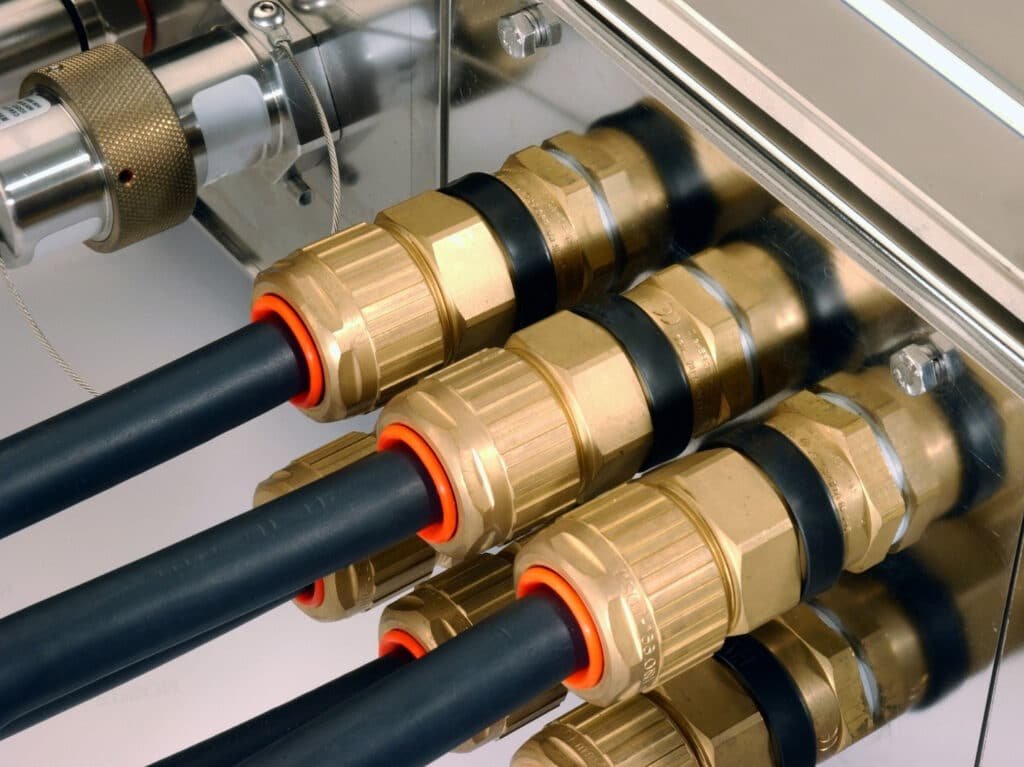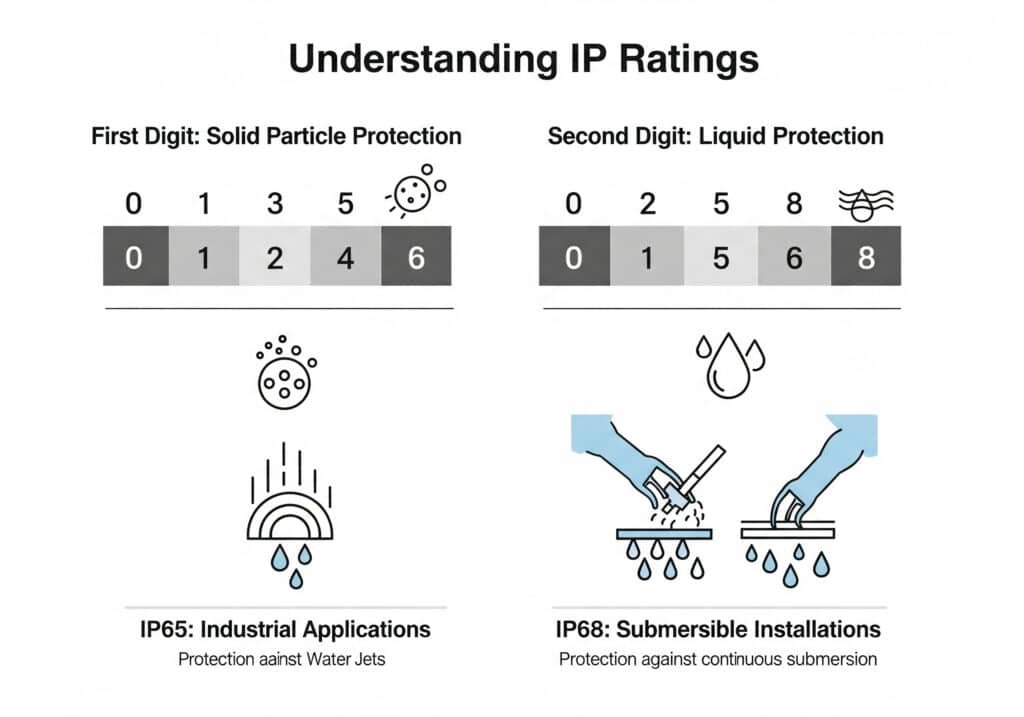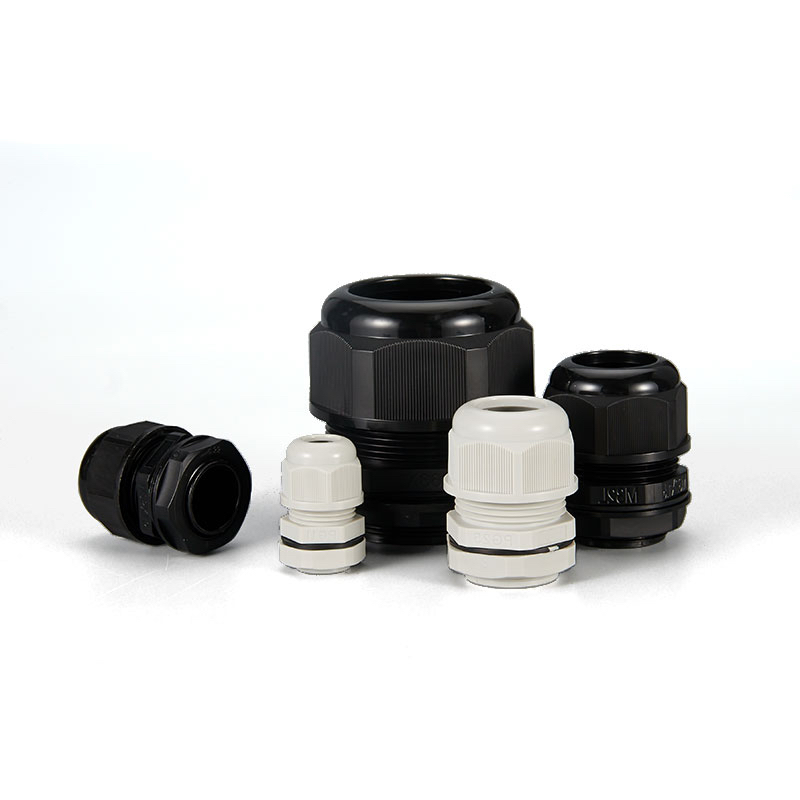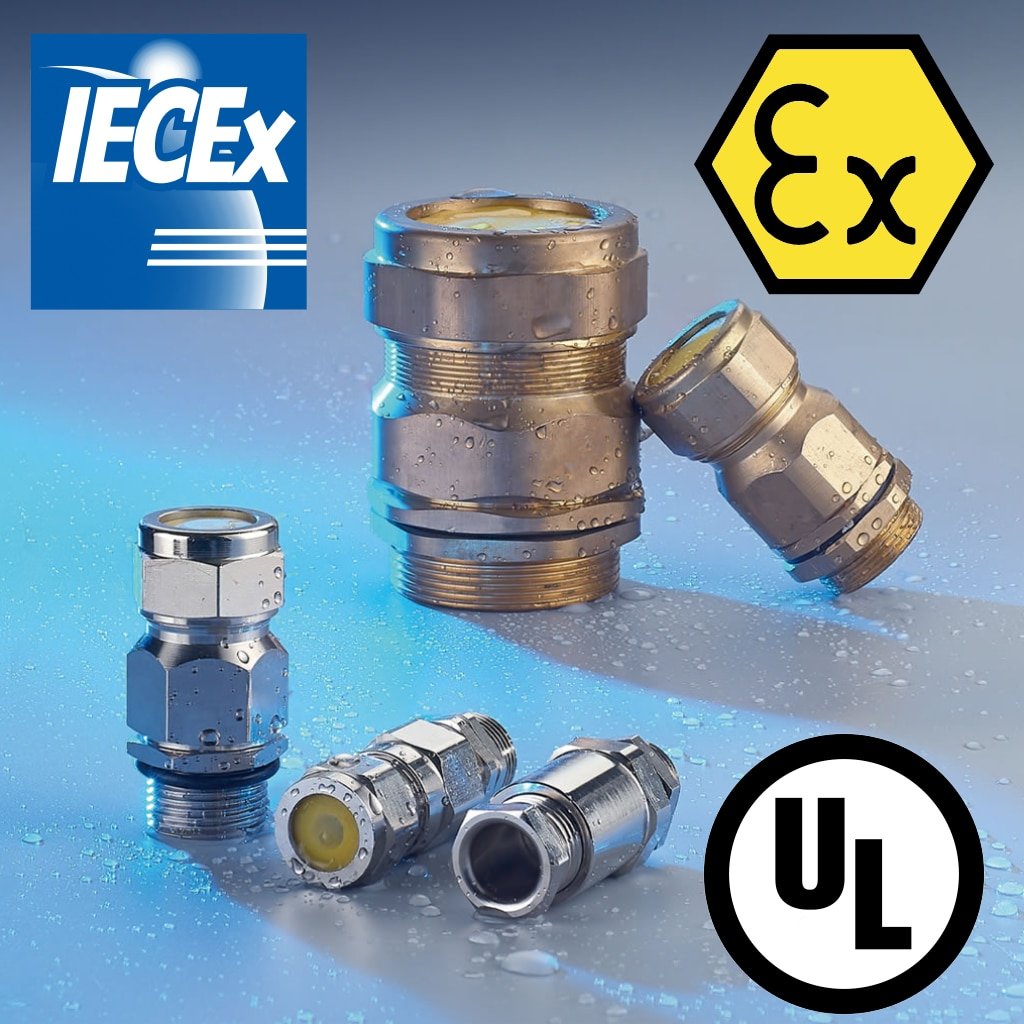You’re staring at a cable installation project, wondering which cable gland will actually work. The wrong choice means leaks, failures, and costly rework.
As Bepto’s sales director with 10+ years in cable gland manufacturing, I’ll answer the 10 most critical questions that determine project success – from material selection to IP ratings.
Last week, a frustrated engineer called me after his “waterproof” glands failed spectacularly during the first rain. Don’t let this be you.
Table of Contents
- What exactly is a cable gland and why do I need one?
- How do I choose between nylon, brass, and stainless steel cable glands?
- What’s the difference between IP ratings and which one should I choose?
- When do I need explosion-proof or ATEX certified cable glands?
What exactly is a cable gland and why do I need one?
Think you can just drill a hole and push cables through? Think again.
A cable gland is a mechanical device that securely attaches and seals cables to equipment enclosures, providing strain relief, environmental protection, and maintaining IP ratings.

The Three Critical Functions Every Cable Gland Must Perform
Here’s what happens when you skip proper cable glands – I’ve seen it countless times:
- Strain Relief1: Without proper strain relief, cables get yanked out during maintenance or vibration
- Environmental Sealing: Moisture creeps in, causing shorts and equipment failure
- Cable Retention: Loose cables create intermittent connections that drive technicians crazy
Real Customer Story: David, a procurement manager from Germany, called us frantically last month. His team had used cheap plastic cable entries instead of proper glands. Result? Water damage worth €50,000 after one storm. We shipped him our IP68-rated nylon glands overnight, and his problems disappeared.
Cable Gland vs. Cable Entry: What’s the Difference?
| Feature | Cable Gland | Basic Cable Entry |
|---|---|---|
| Strain Relief | ✅ Built-in compression | ❌ None |
| IP Rating | ✅ IP65-IP68 available | ❌ Usually IP20 max |
| Cable Retention | ✅ Mechanical grip | ❌ Friction only |
| Cost | Higher upfront | Lower upfront, higher long-term |
How do I choose between nylon, brass, and stainless steel cable glands?
Material choice isn’t just about budget – it’s about survival in your specific environment.
Nylon glands offer excellent chemical resistance and cost-effectiveness for most applications, brass provides superior mechanical strength and EMC shielding, while stainless steel delivers ultimate corrosion resistance for harsh marine or chemical environments.

The Material Selection Matrix I Use With Every Customer
Nylon Cable Glands – The Versatile Workhorse
- Best for: General industrial, food processing, chemical resistance needed
- Temperature range: -40°C to +100°C
- Key advantage: Outstanding chemical resistance, lightweight
- Avoid when: High mechanical stress or EMC shielding required
Brass Cable Glands – The EMC Champion
- Best for: Electronic equipment, control panels, EMC-sensitive applications
- Temperature range: -40°C to +120°C
- Key advantage: Excellent EMC shielding2, good mechanical strength
- Avoid when: Marine environments (corrosion risk)
Stainless Steel Cable Glands – The Ultimate Survivor
- Best for: Marine, offshore, chemical plants, extreme environments
- Temperature range: -60°C to +200°C
- Key advantage: Superior corrosion resistance, highest mechanical strength
- Consider cost: 3-5x more expensive than nylon
Hassan’s $2 Million Decision
Hassan, who runs a petrochemical facility in the Middle East, initially wanted to save money with brass glands for his new expansion. I had to be direct: “Hassan, one corrosion failure in your environment could cost millions. The extra $15,000 for stainless steel glands is insurance.”
He chose our 316L stainless steel ATEX-certified glands. Two years later, he thanked me – nearby facilities using cheaper alternatives had multiple failures during sandstorms.
What’s the difference between IP ratings and which one should I choose?
IP ratings aren’t marketing fluff – they’re your protection guarantee against the elements.
IP ratings3 define ingress protection levels: the first digit (0-6) indicates solid particle protection, the second digit (0-8) shows liquid protection, with IP65 suitable for most industrial applications and IP68 required for submersible installations.

Decoding IP Ratings: What Those Numbers Actually Mean
| IP Rating | Dust Protection | Water Protection | Typical Applications |
|---|---|---|---|
| IP54 | Limited dust | Splash resistant | Indoor control panels |
| IP65 | Dust tight | Water jets | Outdoor equipment |
| IP66 | Dust tight | Powerful water jets | Marine deck equipment |
| IP67 | Dust tight | Temporary immersion (1m) | Underground installations |
| IP68 | Dust tight | Continuous submersion | Underwater applications |
The IP Rating Reality Check
Here’s what I tell every customer: IP ratings are only as good as your installation.
Common Installation Mistakes That Kill IP Ratings:
- Over-tightening (cracks the seal)
- Under-tightening (allows water ingress)
- Wrong cable diameter (seal doesn’t compress properly)
- Damaged threads (no seal possible)
Pro Tip: We always recommend IP65 minimum for outdoor applications. Yes, it costs 20% more than IP54, but I’ve never had a callback on a properly installed IP65 gland.
When IP68 Is Non-Negotiable
David learned this the hard way. His equipment was rated IP65, but installed in a location that occasionally flooded. “Chuck,” he said, “I need glands that can handle being underwater for hours.”
That’s IP68 territory. Our submersible glands have been tested at 10 meters depth for 72 hours. They cost more, but David’s equipment now survives every flood season.
When do I need explosion-proof or ATEX certified cable glands?
One spark in the wrong environment doesn’t just damage equipment – it can be catastrophic.
ATEX-certified4 explosion-proof cable glands are mandatory in hazardous areas classified as Zone 1 or Zone 2, where flammable gases, vapors, or dust may be present, providing flame-proof enclosure and preventing ignition sources.
Understanding Hazardous Area Classifications
Zone Classification Quick Reference:
- Zone 0: Explosive atmosphere continuously present (rare)
- Zone 1: Explosive atmosphere likely during normal operation
- Zone 2: Explosive atmosphere unlikely, but possible during abnormal conditions
Gas Groups You Need to Know:
- Group IIA: Propane, petrol vapor (most common)
- Group IIB: Ethylene (more dangerous)
- Group IIC: Hydrogen, acetylene (most dangerous)
The Certification Maze: What You Actually Need
ATEX Marking Breakdown:
- Ex d: Flame-proof enclosure
- Ex e: Increased safety
- Ex ia/ib: Intrinsic safety5
- Temperature Class: T1-T6 (surface temperature limits)
Real Talk: Don’t try to navigate ATEX alone. Hassan’s facility required Ex d IIC T6 glands for their hydrogen processing area. We provided full documentation and installation guidance – because in hazardous areas, there’s no room for guesswork.
Why We Don’t Cut Corners on ATEX
Our ATEX glands undergo rigorous testing:
- Flame propagation tests
- Impact resistance testing
- Temperature cycling
- Corrosion resistance verification
The Bottom Line: ATEX certification isn’t optional – it’s life safety. We’ve invested heavily in our ATEX testing facility because your safety is non-negotiable.
Conclusion
Choose the right cable gland now, or deal with expensive failures later – material, IP rating, and certifications matter.
FAQs About Cable Glands
Q: Can I use nylon cable glands outdoors?
A: Yes, our UV-stabilized nylon glands are designed for outdoor use with temperature ratings from -40°C to +100°C. They offer excellent weather resistance and won’t become brittle under UV exposure.
Q: What’s the difference between metric and PG thread cable glands?
A: Metric threads (M12, M16, M20) have finer pitch and are becoming the global standard, while PG threads (PG7, PG9, PG11) are traditional European sizes. Both seal equally well when properly installed.
Q: How do I know what cable diameter range my gland will accept?
A: Each gland size has a specific cable diameter range – for example, our M20 glands typically accept 6-12mm cables. Always check our technical specifications and choose a gland where your cable diameter falls in the middle of the range for optimal sealing.
Q: Can cable glands be reused after removal?
A: While technically possible, we don’t recommend reusing cable glands as the sealing elements may be compromised. For critical applications, always use new glands to maintain IP ratings and reliability.
Q: What’s the maximum number of cables I can put through one cable gland?
A: Standard cable glands are designed for single cables. For multiple cables, use our multi-cable glands or cable entry systems that maintain proper sealing around each individual cable.
-
Learn the engineering principles of strain relief and why it is essential for protecting cable terminations. ↩
-
Explore the fundamentals of Electromagnetic Compatibility (EMC) and how shielding is used to protect against interference. ↩
-
Review the official International Electrotechnical Commission (IEC) standard that defines the IP code for Ingress Protection ratings. ↩
-
Access the official European Commission page for the ATEX Directive on equipment for potentially explosive atmospheres. ↩
-
Understand the principles of Intrinsic Safety (IS), a protection technique for safe operation of electrical equipment in hazardous areas. ↩




